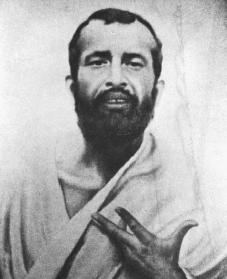Life and teachings of Shri Ramakrishna Paramhamsa And shree Sarada MAA.
BHOBO SAGUARO TARON KARON HEY.
ROBI NANDO BONDONO KHONDONO HEY.
SARNAGOTO KINGKORO BHITO MONE.
GURU DEVO DOYO KORO DINO JONE.
GURU DEVO KRIPA KORO GYANO HINE.
Shri Rama Krishna, if anybody in this materialist had seen god in real meaning, then only one name that first strikes in our mind is Shri Shri Rama Krishna Paramhamsa. He had seen god inexact meaning. Shri Ramakrishna had seen god in all human beings. He says that if you want to get god, then one shouldn't misbehave with anybody in this world, because God is there inside everyone.
LIFE OF SRI SRI RAMAKRISHNA PARAMHANSA :
Shri RAMA KRISHNA comes from a poor family. His real name is Gadadhar. He was very calm by nature early from his childhood.
Born: February 18, 1833
Kamapukur, India
Died: August 16, 1886
Calcutta, India
Indian religious leader and mystic:
Kamapukur, India
Died: August 16, 1886
Calcutta, India
Indian religious leader and mystic:
Sri Ramakrishna was an Indian mystic (one whose religious beliefs are based on spirituality and practices outside of traditional religion), reformer, and saint who, in his own lifetime, came to be hailed by people of all classes as a spiritual embodiment (taking on the physical form) of God.
His childhood:
Born in a rural Bengal village in India, Sri Ramakrishna was the fourth of five children. His parents were simple but traditional Brahmins (Hindu religion) deeply committed to the maintenance of traditional religious piety, or religious devotion. Legend has it that when Ramakrishna's father, Khudiram, made a pilgrimage (religious journey) to the holy place of Gaya, he had a vision of the Hindu god Vishnu, who told Khudiram he would be reincarnated (take the form) of his next son. Likewise, Ramakrishna's mother, Chandra Devi, had visions that her next born would be divine (god-like) child. Shortly afterward, Chandra Devi gave birth to Sri Ramakrishna.
As a child, Ramakrishna did not like routine schoolwork and never learned to read or write. Instead, he began to demonstrate spiritual qualities well beyond his years, which included experiencing intensely joyful experiences, long periods of thought, and spiritual absorption in the sacred (holy) and traditional Indian plays, especially with the roles of the gods Shiva and Krishna. During his formal initiation ceremony into the Brahmin caste (an Indian social class), he shocked his high-caste relatives by openly accepting a ritual meal cooked by a woman of low caste.
Though Ramakrishna resisted traditional priestly studies, at the age of sixteen he went to Calcutta, India, to assist his brother, who was serving as a priest for a number of local families. He was disturbed by the gross business practices and inhumanity of the city environment. However, when his brother was asked to become a priest at a large temple complex at Dakshineswar near the Ganges River outside Calcutta, Ramakrishna found a new and ultimately permanent environment for his spiritual growth and teaching.
His spiritual struggle:
That temple complex—one of the most impressive in the area—had been built by a wealthy widow of a low caste whose spiritual ideal (standard) was the mother goddess Kali. This great deity (god) traditionally combines the terror of death and destruction with universal motherly security and is often represented in a statue of ferocious appearance. She represents an immense variety of religious and human emotions, from the most primitive to the highest forms, and therefore has a symbolic universality not easily contained within traditional religious forms.
Ramakrishna was selected to serve as a priest in the Kali temple, and it was here that he had a series of important religious experiences in which he felt that Kali was calling him to a universal spiritual mission for India and all mankind. His untraditional and often bizarre behavior during this period of spiritual transformation was interpreted by many as a sign of madness. However, it clearly represented his struggles to free himself from routine religious patterns and to achieve a new and deeper spirituality. He imitated the actions of the god-monkey Hanuman (a sign of humility and service); he fed animals from the same food prepared for Kali (a disrespect to the traditionalists); he cleaned an outcaste's hovel (the shack

Sri Ramakrishna.
Without studying Ramakrishna Paramahamsa first, one can never understand the real import of the Vedas, the Vedanta, of the Bhagavata and the other Puranas.
His life is a searchlight of infinite power thrown upon the whole mass of Indian religious thought. He was the living commentary to the Vedas and to their aim. He had lived in one life the whole cycle of the national religious existence in India. Ramakrishna Paramhamsathe latest and the most perfect - the concentrated embodiment of knowledge, love, renunciation, catholicity, and the desire to serve mankind. So where is anyone to compare with him? He must have been born in vain who cannot appreciate him!
In praise of Shri Ramakrishna , swami vivekananda says that "My supreme good fortune is that Iam his servant throughout life after life".
A single word of his is to me for weighter than the vedas and the vedanta.






Post a Comment